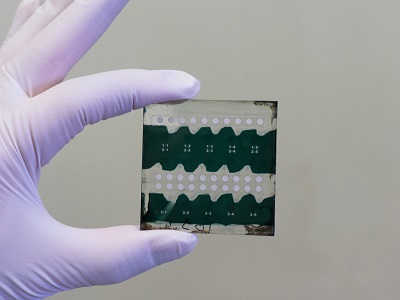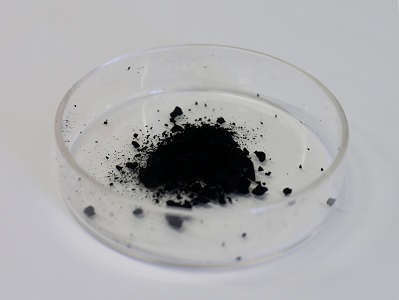Toyobo accelerates development of photoelectric conversion material for organic photodiodes; successfully makes prototype module with world-leading*1 sensitivity in collaboration with French research organization CEA
Toyobo Co., Ltd. is accelerating development of an organic photoelectric conversion material that converts light energy to electrical energy. In the latest step in this endeavor, Toyobo successfully made a prototype module of organic photodiodes (OPD) featuring this material, which has superb sensitivity, due to one of the world’s lowest levels*1 of dark current*2. This research was conducted in collaboration with CEA, a French government energy research institute using the material for organic photodiodes. Virtually every new device is capable of connecting to the Internet, so Toyobo aims to have this material used as an optical sensor for Internet of Things (IoT) devices by the end of 2025.

OPD prototype module developed jointly with CEA

Photoelectric conversion material for OPD
Various electronic devices have optical sensors that detect the brightness of light. At present, photodiodes that convert differences in light intensity to electric signals are manufactured mainly through high-temperature vapor deposition on a glass substrate of a photoelectric conversion material composed of silicon and other inorganic substances. OPD that Toyobo is developing can be manufactured in a simpler method, in which an organic photoelectric conversion material is dissolved in a solution and then coated on a glass or plastic substrate. This reduces production costs and associated environmental impacts, compared with those of conventional photodiodes. Furthermore, the use of films and other flexible materials as a substrate allows greater freedom in shaping target components, broadening the range of photosensor applications and opening the door to extensive use in various industries.
Toyobo has been developing a diverse range of organic materials by harnessing its sophisticated organic synthesis technologies. Since 2019, Toyobo and CEA have conducted joint research on a power-generating material for organic photovoltaics*3. Moreover, since 2020, Toyobo and CEA have been jointly developing an organic photoelectric conversion material for photosensors, which are indispensable for IoT. This research has culminated in a prototype OPD module with excellent sensitivity capable of detecting weaker light than silicon photodiodes already on the market can detect. Specifically, this prototype attained one of the world’s lowest levels of dark current, or below 10-9 A/cm2 when subjected to the voltage of -5V, the benchmark for commercial application. In a joint verification with CEA, Toyobo’s photoelectric conversion material was confirmed to have the same level of dark current when coated on either a glass substrate or polyethylene terephthalate (PET) film substrate.
Toyobo is committed to creating a safer society that gives people peace of mind by putting into practical use as soon as possible the material for advanced photosensors which require low dark current used for IoT electrical appliances, fingerprint authentication devices and other product.
| *1 | According to Toyobo’s study as of March 23, 2022. |
| *2 | An electrical current when light is not irradiated. The lower the dark current, the higher the sensitivity of a photosensor. |
| *3 | Refer to Toyobo’s news release dated July 31, 2019, https://www.toyobo-global.com/news/2019/release_101.html Refer to Toyobo’s news release dated March 23, 2020, https://www.toyobo-global.com/news/2020/release_117.html |
About CEA
The CEA is a key player in research, development and innovation in four main areas: energy transition, digital transition, technology for the medicine of the future and defense and security. With a workforce of 20,000 people, based in nine sites equipped with very large-scale research infrastructures, the CEA actively participates in collaborative projects with a large number of academic and industrial partners, in France, Europe and worldwide. According to the Clarivate 2022 ranking, the CEA is in The Top 100 Global Innovators, in terms of number of patents filed in France and Europe.
For more information: www.cea.fr
For more information, contact
Public Relations Group, Corporate Communication Department, Toyobo Co., Ltd.
MAILpr_g@toyobo.jp
Cautionary Statement
This website contains forward-looking statements that reflect Toyobo's plans and expectations. These forward-looking statements are not guarantees of future performance and involve known and unknown risks, uncertainties and other factors that may cause Toyobo's actual results, performance, achievements or financial position to be materially different from any future results, performance, achievements or financial position expressed or implied by these forward-looking statements.






